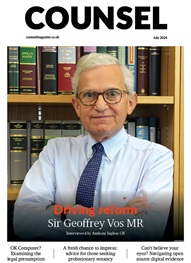*/

Cryptoassets are mainstream these days: the Financial Conduct Authority (FCA) reported a rise of 400,000 investors since March 2020, and 2.3 million UK adults now hold cryptoassets. This brings opportunity for fraudsters who target cryptoassets or use crypto to dissipate assets from any fraud. Our collaboration with Asset Reality and Chainalysis will help support the ecosystem of this revolutionary technology by providing a streamlined in-house cradle-to-grave investigation and asset recovery service.
The recovery of misappropriated cryptoassets has many success stories, but this has not yet deterred criminals, and we have seen adaptation to the changing environment as enforcement agencies and asset recovery specialists flex their muscles. Ransomware attacks were reportedly up 311% between 2019 and 2020, with USD350 million paid by victims.* The number is likely to be far higher when you consider thwarted and unreported attacks. Individual payments to wallet addresses known for scams are up from 5 million to 7.3 million in the same period; a 48% increase in victims.* Criminals are using mixers and tumblers to obfuscate their trails, and even pose as an asset recovery specialist or a party connected to a bad actor. Some victims are so overcome from the first attack that they will seize on any hope, often paying the price a second time.
It is not that different. Blockchain analysis allows us to trace the flow of funds through an unlimited number of hops (akin to having every bank statement you need). Some working in this space can be too focused on this element and there are benefits to applying more ‘traditional’ asset tracing techniques to broaden the scope of the investigation. Corporate intelligence skills, including the use of OSINT, domain name investigations and social media capture can help identify ‘real world’ targets. Receiverships or insolvency procedures bring significant powers of investigation and a wide range of recovery actions.
There is a strong appetite within UK government agencies to get to grips with this trend. Met Police seizures have proven that these assets are traceable, storable and sellable. Our webinars with HMRC, the National Crime Agency and the Insolvency Service are among the most popular we have ever held. Judging by the recent report of HMRC sending ‘nudge’ letters to crypto investors over unpaid tax, it is just a matter of time before they will be on the cryptoasset seizure leaderboard. We are still in the ‘temporary registration regime’ stage of regulation so it is probably premature to talk about stronger regulation. The vast majority of cryptoasset use is for legitimate purposes and, given the huge variation in government approaches across the world, the UK has an opportunity to support this nascent space and derive the economic benefits. The real issue is how government agencies and asset recovery professionals will be empowered to pursue criminals, who find victims on social media platforms safe in the knowledge that tech giants are ineffective gate-keepers. The Online Safety Bill is interesting; the government has agreed to tackle online scams following pressure from the FCA and others, although not fraud via advertising, emails or cloned websites.
Maintaining this status will rely on a collective will to support the cryptoasset ecosystem and bring it further into the mainstream. The decentralised nature of crypto may make it resistant to traditional regulation, but it behoves all levels of investor to have some sort of recourse in the event of fraud. More streamlined and cost-effective investigation and asset recovery can help, and CFAAR (the network of lawyers, forensic accountants, corporate intelligence and asset recovery professionals focused on crypto fraud and asset recovery) will encourage a collaborative mindset focused on enforcing the judgments of our courts and achieving restitution for victims.

Cryptoassets are mainstream these days: the Financial Conduct Authority (FCA) reported a rise of 400,000 investors since March 2020, and 2.3 million UK adults now hold cryptoassets. This brings opportunity for fraudsters who target cryptoassets or use crypto to dissipate assets from any fraud. Our collaboration with Asset Reality and Chainalysis will help support the ecosystem of this revolutionary technology by providing a streamlined in-house cradle-to-grave investigation and asset recovery service.
The recovery of misappropriated cryptoassets has many success stories, but this has not yet deterred criminals, and we have seen adaptation to the changing environment as enforcement agencies and asset recovery specialists flex their muscles. Ransomware attacks were reportedly up 311% between 2019 and 2020, with USD350 million paid by victims.* The number is likely to be far higher when you consider thwarted and unreported attacks. Individual payments to wallet addresses known for scams are up from 5 million to 7.3 million in the same period; a 48% increase in victims.* Criminals are using mixers and tumblers to obfuscate their trails, and even pose as an asset recovery specialist or a party connected to a bad actor. Some victims are so overcome from the first attack that they will seize on any hope, often paying the price a second time.
It is not that different. Blockchain analysis allows us to trace the flow of funds through an unlimited number of hops (akin to having every bank statement you need). Some working in this space can be too focused on this element and there are benefits to applying more ‘traditional’ asset tracing techniques to broaden the scope of the investigation. Corporate intelligence skills, including the use of OSINT, domain name investigations and social media capture can help identify ‘real world’ targets. Receiverships or insolvency procedures bring significant powers of investigation and a wide range of recovery actions.
There is a strong appetite within UK government agencies to get to grips with this trend. Met Police seizures have proven that these assets are traceable, storable and sellable. Our webinars with HMRC, the National Crime Agency and the Insolvency Service are among the most popular we have ever held. Judging by the recent report of HMRC sending ‘nudge’ letters to crypto investors over unpaid tax, it is just a matter of time before they will be on the cryptoasset seizure leaderboard. We are still in the ‘temporary registration regime’ stage of regulation so it is probably premature to talk about stronger regulation. The vast majority of cryptoasset use is for legitimate purposes and, given the huge variation in government approaches across the world, the UK has an opportunity to support this nascent space and derive the economic benefits. The real issue is how government agencies and asset recovery professionals will be empowered to pursue criminals, who find victims on social media platforms safe in the knowledge that tech giants are ineffective gate-keepers. The Online Safety Bill is interesting; the government has agreed to tackle online scams following pressure from the FCA and others, although not fraud via advertising, emails or cloned websites.
Maintaining this status will rely on a collective will to support the cryptoasset ecosystem and bring it further into the mainstream. The decentralised nature of crypto may make it resistant to traditional regulation, but it behoves all levels of investor to have some sort of recourse in the event of fraud. More streamlined and cost-effective investigation and asset recovery can help, and CFAAR (the network of lawyers, forensic accountants, corporate intelligence and asset recovery professionals focused on crypto fraud and asset recovery) will encourage a collaborative mindset focused on enforcing the judgments of our courts and achieving restitution for victims.


The Chair of the Bar sets out how the new government can restore the justice system
In the first of a new series, Louise Crush of Westgate Wealth considers the fundamental need for financial protection
Unlocking your aged debt to fund your tax in one easy step. By Philip N Bristow
Possibly, but many barristers are glad he did…
Mental health charity Mind BWW has received a £500 donation from drug, alcohol and DNA testing laboratory, AlphaBiolabs as part of its Giving Back campaign
The Institute of Neurotechnology & Law is thrilled to announce its inaugural essay competition
How to navigate open source evidence in an era of deepfakes. By Professor Yvonne McDermott Rees and Professor Alexa Koenig
Brie Stevens-Hoare KC and Lyndsey de Mestre KC take a look at the difficulties women encounter during the menopause, and offer some practical tips for individuals and chambers to make things easier
Sir Geoffrey Vos, Master of the Rolls and Head of Civil Justice since January 2021, is well known for his passion for access to justice and all things digital. Perhaps less widely known is the driven personality and wanderlust that lies behind this, as Anthony Inglese CB discovers
The Chair of the Bar sets out how the new government can restore the justice system
No-one should have to live in sub-standard accommodation, says Antony Hodari Solicitors. We are tackling the problem of bad housing with a two-pronged approach and act on behalf of tenants in both the civil and criminal courts